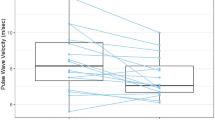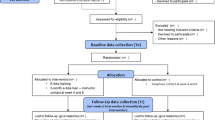Abstract
Introduction
Pedelecs are bicycles that provide electric assistance only when a rider is pedaling and have become increasingly popular.
Purpose
Our purpose was to quantify usage patterns over 4 weeks of real-world commuting with a pedelec and to determine if pedelec use would improve cardiometabolic risk factors.
Methods
Twenty sedentary commuters visited the laboratory for baseline physiological measurements [body composition, maximum oxygen consumption (\(\dot{V}{\text{O}}_{ 2} { \hbox{max} }\)), mean arterial blood pressure (MAP), blood lipid profile, and 2-h oral glucose tolerance test (OGTT)]. The following 4 weeks, participants were instructed to commute using a pedelec at least 3 days week−1 for 40 min day−1 while wearing a heart rate monitor and a GPS device. Metabolic equivalents (METS) were estimated from heart rate data. Following the intervention, we repeated the physiological measurements.
Results
Average total distance and time were 317.9 ± 113.8 km and 15.9 ± 3.4 h, respectively. Participants averaged 4.9 ± 1.2 METS when riding. Four weeks of pedelec commuting significantly improved 2-h post-OGTT glucose (5.53 ± 1.18–5.03 ± 0.91 mmol L−1, p < 0.05), \(\dot{V}{\text{O}}_{ 2} { \hbox{max} }\) (2.21 ± 0.48–2.39 ± 0.52 L min−1, p < 0.05), and end of \(\dot{V}{\text{O}}_{ 2} { \hbox{max} }\) test power output (165.1 ± 37.1–189.3 ± 38.2 W, p < 0.05). There were trends for improvements in MAP (84.6 ± 10.5–83.2 ± 9.4 mmHg, p = 0.15) and fat mass (28.6 ± 11.3–28.2 ± 11.4 kg, p = 0.07).
Conclusion
Participants rode a pedelec in the real world at a self-selected moderate intensity, which helped them meet physical activity recommendations. Pedelec commuting also resulted in significant improvements in 2-h post-OGTT glucose, \(\dot{V}{\text{O}}_{ 2} { \hbox{max} }\), and power output. Pedelecs are an effective form of active transportation that can improve some cardiometabolic risk factors within only 4 weeks.


Similar content being viewed by others
Abbreviations
- BMI:
-
Body mass index
- DXA:
-
Dual energy X-ray absorptiometry
- GXT:
-
Graded exercise test
- HDL:
-
High-density lipoprotein
- HOMA:
-
Homeostasis model assessment
- LDL:
-
Low-density lipoprotein
- MAP:
-
Mean arterial blood pressure
- METS:
-
Metabolic equivalents
- OGTT:
-
Oral glucose tolerance test
- RPE:
-
Rating of perceived exertion
- \(\dot{V}{\text{O}}_{ 2} { \hbox{max} }\) :
-
Maximum oxygen consumption
- WHO:
-
World Health Organization
References
Bike Europe Web Site [Internet] (2016a) EU-2010: E-bikes rising star in all major markets. http://www.bike-eu.com/Sales-Trends/Market-Report/2011/9/bEU-2010b-E-bikes-Rising-Star-in-All-Major-Markets-BIK005299W/. Accessed Feb 5 2016
Bike Europe Web Site [Internet] (2016b) Speed e-bike sales scores 30 % growth in Holland. http://www.bike-eu.com/sales-trends/nieuws/2016/1/speed-e-bike-sales-scores-30-growth-in-holland-10125408. Accessed 10 Jan 2016
de Geus B, Van Hoof E, Aerts I, Meeusen R (2008) Cycling to work: influence on indexes of health in untrained men and women in Flanders. Coronary heart disease and quality of life. Scand J Med Sci Sports 18(4):498–510
de Geus B, Joncheere J, Meeusen R (2009) Cycling to work: influence on indexes of health in untrained men and women in Flanders: minimum dose to improve indexes of fitness. Scand J Med Sci Sports 19(2):179–187
de Geus B, Kempenaers F, Lataire P, Meeusen R (2013) Influence of electrically assisted cycling on physiological parameters in untrained subjects. Eur J Sport Sci 13(3):290–294
Donnelly JE, Honas JJ, Smith BK et al (2013) Aerobic exercise alone results in clinically significant weight loss for men and women: midwest exercise trial 2. Obesity 21(3):E219–E228
Dunstan DW, Kingwell BA, Larsen R et al (2012) Breaking up prolonged sitting reduces postprandial glucose and insulin responses. Diabetes Care 35(5):976–983
Durstine JL, Grandjean PW, Davis PG, Ferguson MA, Alderson NL, DuBose KD (2001) Blood lipid and lipoprotein adaptations to exercise: a quantitative analysis. Sports Med 31(15):1033–1062
Durstine JL, Grandjean PW, Cox CA, Thompson PD (2002) Lipids, lipoproteins, and exercise. J Cardiopulm Rehabil 22(6):385–398
Frank LD, Andresen MA, Schmid TL (2004) Obesity relationships with community design, physical activity, and time spent in cars. Am J Prev Med 27(2):87–96
Freedson PS, Melanson E, Sirard J (1998) Calibration of the Computer Science and Applications, Inc. accelerometer. Med Sci Sports Exerc 30(5):777–781
Gojanovic B, Welker J, Iglesias K, Daucourt C, Gremion G (2011) Electric bicycles as a new active transportation modality to promote health. Med Sci Sports Exerc 43(11):2204–2210
Grant RW, Dixit VD (2015) Adipose tissue as an immunological organ. Obesity 23(3):512–518
Healy GN, Dunstan DW, Salmon J et al (2007) Objectively measured light-intensity physical activity is independently associated with 2-h plasma glucose. Diabetes Care 30(6):1384–1389
Hendriksen IJ, Zuiderveld B, Kemper HC, Bezemer PD (2000) Effect of commuter cycling on physical performance of male and female employees. Med Sci Sports Exerc 32(2):504–510
Herman Hansen B, BØrtnes I, Hildebrand M, Holme I, Kolle E, Anderssen SA (2014) Validity of the Actigraph GT1M during walking and cycling. J Sports Sci 32(6):510–516
Hoehner CM, Barlow CE, Allen P, Schootman M (2012) Commuting distance, cardiorespiratory fitness, and metabolic risk. Am J Prev Med 42(6):571–578
Levitan EB, Song Y, Ford ES, Liu S (2004) Is nondiabetic hyperglycemia a risk factor for cardiovascular disease?: a meta-analysis of prospective studies. Arch Intern Med 164(19):2147–2155
Louis J, Brisswalter J, Morio C, Barla C, Temprado JJ (2012) The electrically assisted bicycle: an alternative way to promote physical activity. Am J Phys Med Rehabil 91(11):931–940
Mansoubi M, Pearson N, Biddle SJ, Clemes SA (2015) Using sit-to-stand workstations in offices: is there a compensation effect? Med Sci Sports Exerc. doi:10.1249/MSS.0000000000000802
Matthews DR, Hosker JP, Rudenski AS, Naylor BA, Treacher DF, Turner RC (1985) Homeostasis model assessment: insulin resistance and beta-cell function from fasting plasma glucose and insulin concentrations in man. Diabetologia 28(7):412–419
Mayo Clinic Web Site [Internet] (2016) Barriers to fitness: overcoming common challenges. http://www.mayoclinic.org/healthy-lifestyle/fitness/in-depth/fitness/art-20045099. Accessed 4 Feb 2016
McKenzie B (2013) Out-of-state and long commutes: 2011. US Censes Bureau
McKenzie B, Rapino M (2011) Commuting in the US: 2009. US Census Bureau
Roca J, Agusti A, Alonso A et al (1992) Effects of training on muscle O2 transport at VO2max. J Appl Physiol 73(3):1067–1076
Saydah SH, Miret M, Sung J, Varas C, Gause D, Brancati FL (2001) Postchallenge hyperglycemia and mortality in a national sample of US adults. Diabetes Care 24(8):1397–1402
Sperlich B, Zinner C, Hebert-Losier K, Born DP, Holmberg HC (2012) Biomechanical, cardiorespiratory, metabolic and perceived responses to electrically assisted cycling. Eur J Appl Physiol 112(2):4015–4025
Statista Web Site [Internet] (2016) Projected worldwide sales of electric bicycles in 2018 by region (in million units). http://www.statista.com/statistics/255658/worldwide-sales-of-electric-bicycles-by-region/. Accessed 10 Jan 2016
van Kruijsdijk RC, van der Wall E, Visseren FL (2009) Obesity and cancer: the role of dysfunctional adipose tissue. Cancer Epidemiol Biomark Prev 18(10):2569–2578
World Health Organization (2010) Global recommendations on physical activity for health. World Health Organization, Geneva
Acknowledgments
Funding for the study was provided by NIH Grant UL1 TR000154, NIH Grant UL1 TR001082, the City of Boulder, and Skratch Labs LLC. The authors thank the staff at the University of Colorado Boulder Clinical Translational Research Center for their assistance in collecting the data, Pete’s Electric Bikes and Elevation Cycles for assistance with the pedelecs, Kevin J. Krizek for assistance in securing funding, and the participants for volunteering their time.
Author information
Authors and Affiliations
Corresponding author
Ethics declarations
Conflict of interest
The authors have no conflict of interests to declare.
Additional information
Communicated by Jean-René Lacour.
Rights and permissions
About this article
Cite this article
Peterman, J.E., Morris, K.L., Kram, R. et al. Pedelecs as a physically active transportation mode. Eur J Appl Physiol 116, 1565–1573 (2016). https://doi.org/10.1007/s00421-016-3408-9
Received:
Accepted:
Published:
Issue Date:
DOI: https://doi.org/10.1007/s00421-016-3408-9




